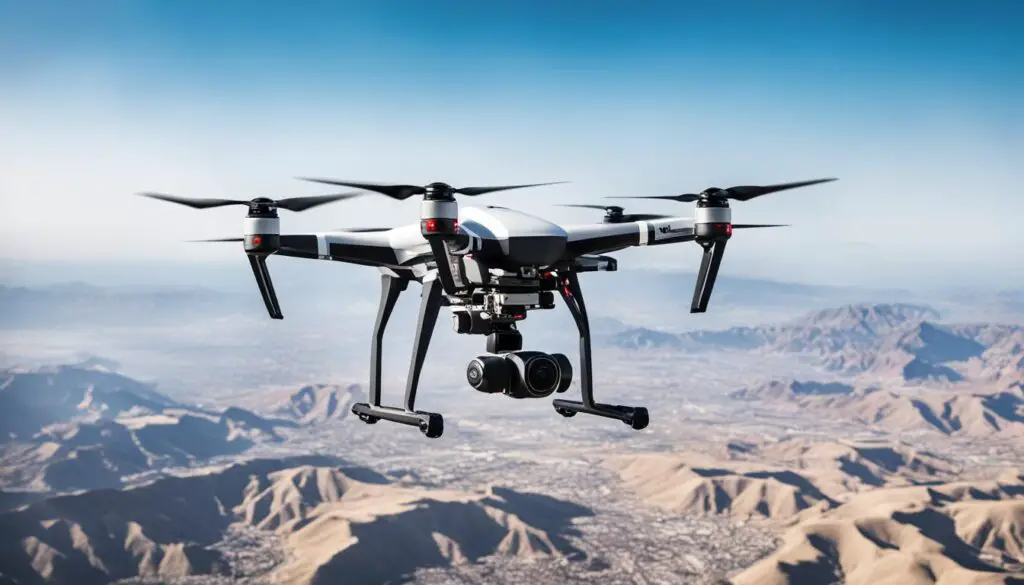
The aviation industry has seen a significant shift in recent years due to the introduction of unmanned aerial vehicles, commonly known as drones. This shift has paved the way for opportunities in the field of drone piloting. As a drone pilot, you will have the chance to work in a fast-growing industry that offers numerous job opportunities and career growth.
This article will provide insights into the job profile, entry opportunities, and salary potential for drone pilots. We will also explore the current regulatory landscape and job prospects for drone pilots in different regions.
If you are interested in pursuing a career in the aviation industry, becoming a drone pilot could be the perfect opportunity for you. Let’s explore the possibilities together.
Job Profile and Tasks of a Drone Pilot
A drone pilot is responsible for operating drones and capturing aerial footage using advanced technology. As the demand for drone technology increases, so does the need for skilled and experienced drone pilots.
The job profile of a drone pilot involves:
- Pre-flight checks to ensure the equipment is ready for use.
- Communicating with ground teams to coordinate flight operations.
- Flying the drone to capture footage and images from desired locations and angles.
- Controlling the drone’s speed and direction, adapting to changes in weather and environmental conditions.
- Problem-solving in the event of equipment malfunction or flight disruptions.
- Post-flight checks and maintenance of equipment.
Drone pilots may be required to operate complex equipment and software, so technical proficiency and attention to detail are crucial.
| Experience Level | Salary Range |
|---|---|
| Entry-Level | $31,000 – $74,000 |
| Mid-Career | $44,000 – $95,000 |
| Experienced | $58,000 – $151,000 |
In terms of salary, an entry-level drone pilot can expect to earn an average salary ranging from $31,000 to $74,000 per year, while experienced pilots can earn up to $151,000 annually. However, salaries may vary depending on factors such as the location, type of employer, and level of experience.
Entry Opportunities for Aspiring Drone Pilots
Becoming a drone pilot requires specialized skills and experience around flight planning, precise flying, and data management. Fortunately, there are various entry opportunities available that provide the necessary knowledge and experience to kick start your drone pilot career.
Training Programs
One of the most common entry opportunities for aspiring drone pilots is through training programs that provide comprehensive instruction on drone piloting techniques and federal regulations. These programs are typically offered by aviation schools, community colleges, and flight training centers. Certifications earned by completing these training programs can also improve job prospects and pay scales.
Internships
Several drone service providers and aviation companies offer internships for students interested in pursuing a career as a drone pilot. These internships usually combine drone piloting experience with on-site technical training and classroom instruction. Apart from honing drone piloting skills, interns may have opportunities to network with industry professionals and develop an understanding of the prevailing technologies in the field.
Apprenticeships
Apprenticeships offer another viable entry opportunity for aspiring drone pilots. Under the guidance of a qualified drone pilot, apprentices receive hands-on training, get an idea of drone maintenance, gain insight into operating different drone models, and learn how to plan and execute drone missions. Apprenticeships may also be accompanied by classroom instruction, technical training, and a certification.
Countries with High Demand for Drone Pilots
As the use of drones continues to expand across industries, the demand for skilled drone pilots is rapidly increasing worldwide. Here are some countries with high demand for this profession:
| Country | Job Market and Growth Opportunities |
|---|---|
| United States | The United States has a rapidly growing drone industry, with the Federal Aviation Administration predicting a tripling of the commercial drone fleet by 2023. This growth is expected to create numerous job opportunities for drone pilots in various industries, including agriculture, construction, and media. |
| China | China is also experiencing strong growth in the drone industry, with industry experts projecting a market size of $12.6 billion by 2025. This growth is expected to create significant employment opportunities for drone pilots in fields such as surveying, mapping, and agriculture. |
| Japan | Japan has been a leader in the drone market, particularly in the development of industrial-use drones. As such, there is a high demand for skilled drone pilots in industries such as precision agriculture, surveying, and disaster response. |
| Australia | Australia has a rapidly growing drone industry, with a projected market value of AUD 10.5 billion by 2030. This growth is expected to create employment opportunities for drone pilots in various industries, including agriculture, energy, and construction. |
| Canada | Drone usage in Canada is expanding in various industries such as agriculture, mining, and oil and gas. This presents exciting growth opportunities for drone pilots in the country, particularly in remote regions where drone usage is critical. |
These countries are just a few examples of places where drone pilots are in high demand. As the use of drones continues to grow and expand across industries worldwide, the demand for skilled drone operators is only expected to increase.


Current Situation of Drone Pilots in the U.S.
Drone pilots in the United States operate under the Federal Aviation Administration’s (FAA) regulations, with the Part 107 ruling covering commercial drone flights. As of 2021, there are over 1.7 million drones registered with the FAA, indicating a tremendous demand for drone pilots in the country.
While the FAA provides guidelines for drone operation, there are currently no formal licenses required to become a drone pilot. However, individuals must pass a knowledge and safety test to acquire a Remote Pilot Certificate from the FAA. The demand for drone pilots in the U.S. comes from a variety of industries, including agriculture, media, construction, and emergency services.
According to the U.S. Bureau of Labor Statistics, the median annual wage for commercial drone pilots is around $50,000, with top earners making upwards of $100,000 per year. The salary for drone pilots is expected to increase as demand for this skill grows.
Industries with High Demand for Drone Pilots in the U.S.
| Industry | Job Outlook |
|---|---|
| Agriculture | 7% growth in jobs from 2019-2029 |
| Media and Entertainment | 4% growth in jobs from 2019-2029 |
| Construction | 5% growth in jobs from 2019-2029 |
| Emergency Services | 6% growth in jobs from 2019-2029 |
As the demand for drone pilots increases, so do the development opportunities and promotion prospects, with the potential to become a Chief Remote Pilot or to pursue consultancy and training opportunities in the U.S. There are also further opportunities to work in development and testing programs conducted by drone manufacturers.
Current Situation of Drone Pilots in Europe
The demand for drone pilots has been on the rise in Europe, thanks to the increasing recognition of the importance of drones in various sectors. The availability of more powerful and affordable drones has led to the development of new applications that are driving the demand for drone pilots across Europe. In this article, we will discuss the situation of drone pilots in Europe, including the regulatory environment, job market, and industries that offer opportunities for drone operators.
Regulatory Environment
The regulatory landscape for drone pilots in Europe has evolved significantly over the past few years. In 2019, the European Union (EU) introduced new regulations that provided a framework for drone operations across the continent. The regulations included a requirement for all drone pilots to obtain proper training and certification before operating drones commercially.
Drone pilots in Europe are required to complete a recognized training course and pass a written exam before they can operate drones commercially. The training course covers topics such as drone safety, flight planning, and navigation, among others. The EU has also established a drone register, which maintains a record of all the registered drones and their pilots.
Job Market
The job market for drone pilots in Europe is growing steadily, and there is increasing demand for skilled operators in various sectors. The use of drones in industries such as agriculture, construction, and surveying has created new job opportunities for drone pilots. Drone pilots can work for a range of clients, including government agencies, private companies, and research organizations.
According to a recent report, the drone services market in Europe is expected to reach $4.4 billion by 2025, driven by the increasing demand for drone-based services in various industries.
Industries That Offer Opportunities for Drone Operators
| Industry | Opportunities for Drone Pilots |
|---|---|
| Agriculture | Surveying of crop health, monitoring of irrigation systems, and tracking of livestock. |
| Construction | Site surveying, progress monitoring, and structural inspections. |
| Transportation | Inspection of transport infrastructure such as bridges, railway lines and roadways. |
| Media and Entertainment | Capture of aerial footage for television, film and the media industry. |
| Emergency Services | Search and rescue, monitoring of disaster areas, and reconnaissance missions. |
As the use of drones becomes more widespread, the demand for drone pilots will continue to grow across various sectors in Europe. Drones are transforming the way industries operate, and skilled pilots are an essential part of this evolution.
Current Situation of Drone Pilots in Other Regions
While the United States and Europe are currently leading in the use and demand for drone pilots, the situation in other regions varies widely. In Asia, countries such as China, Japan, and South Korea have seen a significant increase in the use of drones across industries, including agriculture, construction, and transportation. In parts of Africa, drones are being deployed for humanitarian aid and wildlife conservation efforts.
In Latin America, countries like Brazil and Mexico are experiencing growth in the use of drones for surveillance, mapping, and delivery services. In the Middle East, the use of drones is prevalent in the oil and gas industry, and also in military and security operations.

It is important to note that the regulations surrounding drone operation vary by country and may impact the job market and opportunities for drone pilots in different regions. Despite these variations, the increasing use of drones across various industries in regions beyond the U.S. and Europe indicates a growing need for trained professionals in this field.
Training, Studies, and Application for Drone Pilots
Aspiring drone pilots require training and education, with several courses available to attain the skills and knowledge necessary to operate drones with precision. A combination of practical and theoretical learning is required to excel in this field.
The training programs focus on both technical aspects such as flight planning, navigation, and safety measures, as well as creative elements such as framing shots, camera placement, and capturing compelling footage. It is essential to have a good understanding and awareness of the different regulations and rules that govern drone flight in different countries across the globe.
Several educational institutions offer courses and programs to provide individuals practical, hands-on experience and a comprehensive understanding of the operating systems of drones. These courses cover topics such as the legal and ethical considerations involved, technological advancements, earth observation, photogrammetry, and remote sensing.
Once an aspiring drone pilot completes the appropriate training program, it is time to apply for relevant positions in this field. Companies typically require a portfolio of work that displays the individual’s technical competence and creative flair, including a showreel of professional-grade footage. A good network is essential in this industry, along with staying up-to-date with emerging techniques and technologies.
| Popular Drone Pilot Training Programs | Location(s) | Duration |
|---|---|---|
| Drone Pilot Ground School | Online | 6 weeks – self-paced |
| FAA Part 107 Drone Certification Prep | Online | 7 weeks – self-paced |
| Small Unmanned Aerial Systems (sUAS) Training Program | On-site | 2 days – 5 days |
Individuals interested in pursuing a career as a drone pilot should consider the appropriate training and educational programs available in their respective locations. By attaining the required technical and creative skills and maintaining a good portfolio, aspiring drone pilots can position themselves to take advantage of the currently growing demand for this profession.
Salary, Development Opportunities, and Promotion Prospects for Drone Pilots
Drone pilot salaries vary depending on the geographic location, industry, and level of experience. According to the Bureau of Labor Statistics, the median annual wage for aerial vehicle pilots, including drone pilots, was $105,720 as of May 2020. Entry-level positions typically range from $30,000 to $50,000 annually, while experienced drone pilots can earn upwards of $100,000.
As for development opportunities, drone pilots can expand their skill sets by obtaining additional certifications to operate different types of drones or improve their data analysis abilities. Many companies offer on-the-job training and development programs, which can enhance drone pilots’ potential to advance their careers.
Promotion prospects also depend on the employer and the level of experience. Experienced drone pilots can become lead pilot, supervisor, or manager positions. They may also become technical experts or choose to move into different fields such as drone maintenance or operations management.
Median Annual Wage of Aerial Vehicle Pilots (including Drone Pilots) in Select Industries
| Industry | Median Annual Wage (May 2020) |
|---|---|
| Professional, Scientific, and Technical Services | $84,880 |
| Warehousing and Storage | $56,850 |
| Electric Power Generation, Transmission, and Distribution | $117,910 |
| Construction | $66,530 |
| Agriculture, Forestry, Fishing and Hunting | $63,680 |
Drone pilots can benefit from salary growth and career advancement opportunities as the demand for their skills increases in today’s dynamic aviation industry.
Conclusion
In conclusion, the drone industry is rapidly expanding, offering numerous opportunities for aspiring pilots. This article has explored the job profile and tasks of a drone pilot, as well as the various entry opportunities and training programs available for individuals interested in pursuing a career in this field. We have also highlighted the countries and regions with high demand for drone pilots, including the current regulatory environment and job prospects in the United States, Europe, and other global areas.
Furthermore, we have provided insights into the educational and training requirements for aspiring drone pilots, as well as the salary potential, development opportunities, and promotion prospects available in this field. With the exciting potential that drone technology offers, now is an excellent time to consider a career as a drone pilot in the dynamic aviation industry.
Questions and Answers
What are the job profile and tasks of a drone pilot?
A drone pilot is responsible for operating unmanned aerial vehicles (UAVs) or drones to capture aerial footage, perform inspections, or gather data. Their tasks include pre-flight checks, flight planning, piloting the drone, and post-flight data analysis.
What entry opportunities are available for aspiring drone pilots?
Aspiring drone pilots can pursue various entry opportunities, such as completing training programs offered by drone academies or aviation schools. They can also gain experience through internships or apprenticeships with drone companies or relevant industries.
Which countries have a high demand for drone pilots?
Countries like the United States, Canada, Australia, China, and the United Kingdom have a high demand for drone pilots. These countries have seen significant growth in the drone industry, creating ample job opportunities for skilled professionals.
What is the current situation for drone pilots in the United States?
In the United States, drone pilots must comply with Federal Aviation Administration (FAA) regulations. The demand for drone pilots is high in industries like filmmaking, agriculture, real estate, and infrastructure inspection. The job market is growing, offering favorable prospects for career advancement.
What is the current situation for drone pilots in Europe?
In Europe, drone pilots must adhere to the regulations set by the European Union Aviation Safety Agency (EASA) and respective national authorities. The demand for drone pilots is prominent in industries like aerial photography, surveying, construction, and environmental monitoring.
What is the current situation for drone pilots in other regions?
Outside of the United States and Europe, the drone industry is also growing in regions like Asia, particularly in countries like China, Japan, and South Korea. Additionally, countries in the Middle East and Africa are witnessing an increasing demand for drone pilots in various sectors, including oil and gas, agriculture, and security.
What training and studies are required to become a drone pilot?
To become a drone pilot, individuals can undertake specialized training programs that cover topics such as drone flight operations, airspace regulations, and safety procedures. Some may choose to pursue a degree or diploma in aviation or related fields to gain a more comprehensive understanding of the industry.
How can I apply for a drone pilot position?
To apply for a drone pilot position, you can search for job openings on online job portals or directly approach drone companies, aerial photography studios, construction firms, or other industries that require drone services. Craft a professional resume highlighting your relevant skills and experience.
What is the salary potential for drone pilots, and what are the development opportunities?
The salary of a drone pilot can vary depending on factors such as experience, industry, and location. As they gain expertise, drone pilots can explore opportunities to specialize in specific areas like aerial cinematography, surveying, or inspections. Advancement in career and promotion prospects can be achieved by demonstrating exceptional skills and advanced certifications.
Are there similar jobs or professions related to drone pilots?
Yes, there are similar jobs or professions related to drone pilots. These include aerial photographers, UAV operators, remote sensing specialists, GIS analysts, and inspection technicians. These roles often require skills in operating drones and working with aerial data for specific applications.

